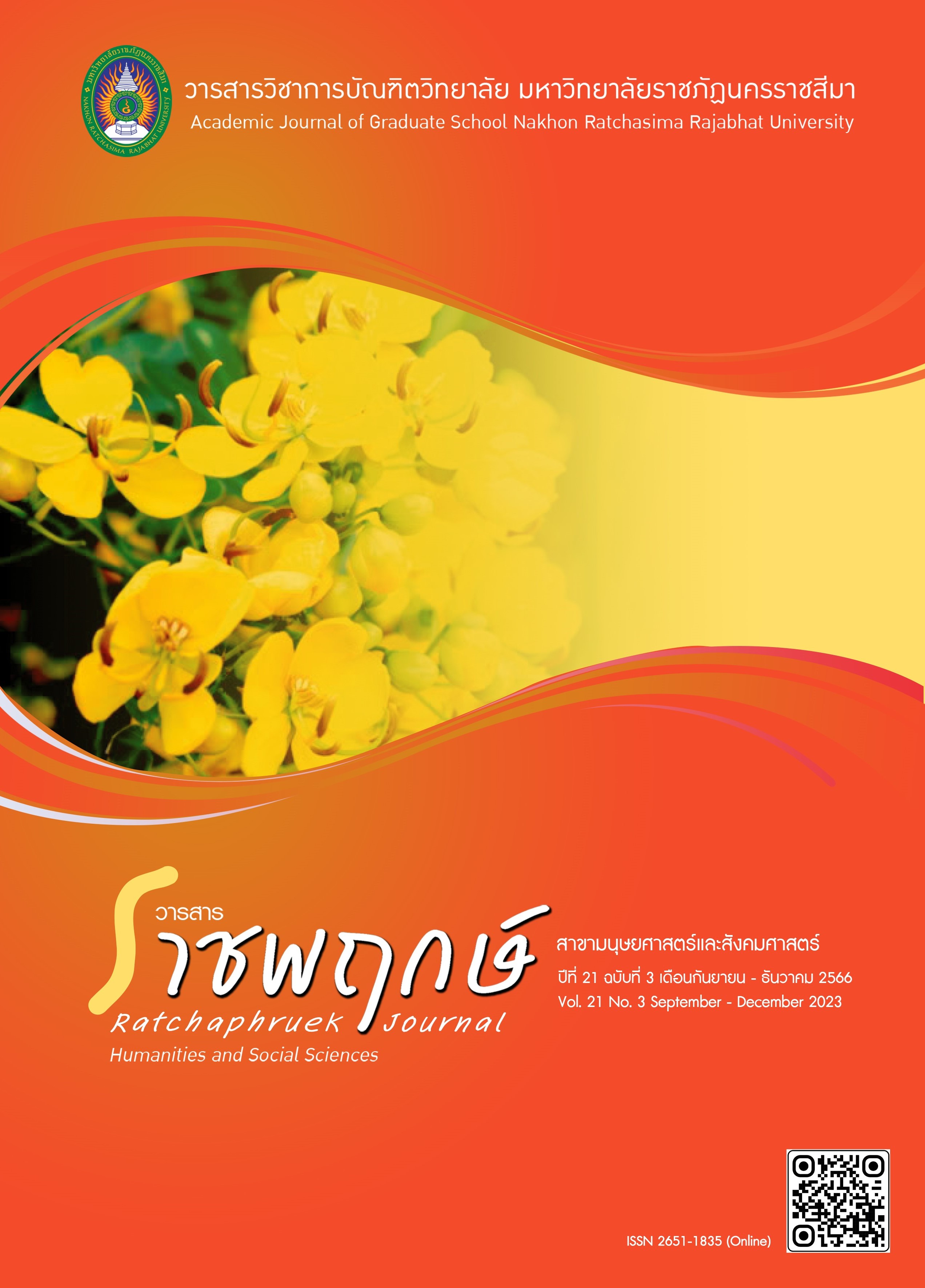The Development of Health Literacy Skills Training Activities on Sex Education to Enhance Perceived Self-Efficacy in Safe Sexual Behaviors of Late Adolescent Students
Main Article Content
Abstract
This study aimed to develop and evaluate activities of health literacy skills training on sex education to enhance perceived self-efficacy in safe sexual behaviors among late adolescent students, conducted in three phases, as follows: (1) studying and reviewing related documents and literature to design the components of the skills training activities; (2) checking the content validity of these activities by seven experts; and (3) evaluating by comparing the mean score before and after the intervention. The sample group consisted of 32 10th-grade students who had low self-efficacy scores, selected by purposive sampling. Data were analyzed using descriptive statistics and the paired sample t-test. The research showed that the health literacy skills training consisted of 5 activities, 100 minutes/activity, one time/week. The content validity index of these activities had a high level--activities 1 and 2 were 0.80, and activities 3 to 5 were 1.00. By the end, the students’ self-efficacy scores had increased significantly to level .05.
Article Details

This work is licensed under a Creative Commons Attribution-NonCommercial-NoDerivatives 4.0 International License.
References
กระทรวงสาธารณสุข, กรมอนามัย. (2563). เปิดสถานการณ์เพศสัมพันธ์ชีวิตร่วมสมัยเด็กไทยประถม 4 เริ่มมองหาเพศตรงข้าม. สืบค้นเมื่อ 15 กันยายน 2565, จาก https://hss.moph. go.th/show_topic.php?id=1066
กระทรวงสาธารณสุข, กรมอนามัย, สำนักอนามัยเจริญพันธุ์. (2565). สถานการณ์อนามัยการเจริญพันธุ์ในวัยรุ่นและเยาวชนปี 2565. สืบค้นเมื่อ 16 สิงหาคม 2566, จาก https://rh.anamai. moph.go.th/th/cms-of-1/download/?did=214353&id=109136&reload=
จุฑามาศ มากกุญชร, นุชนารถ แก้วดำเกิง, สิริพร ภิยโยทัย, ศิริกูล ชัยเจริญ, เบญจมาศ ใจงาม และเกศินี เขียนวารี. (2565). ผลการพัฒนากระบวนการสร้างเสริมความรอบรู้ด้านสุขภาพเรื่อง เอชไอวีและโรคติดต่อทางเพศสัมพันธ์ในกลุ่มผู้มีเชื้อเอชไอวี. วารสารโรคเอดส์, 34(1), น. 1-19.
ชูศรี วงศ์รัตนะ. (2560). เทคนิคการใช้สถิติเพื่อการวิจัย (พิมพ์ครั้งที่ 13). กรุงเทพฯ: ศูนย์หนังสือจุฬาลงกรณ์มหาวิทยาลัย.
เนตรนภา พรหมมา. (2564). การรับรู้ความสามารถของตนเองในการป้องกันการตั้งครรภ์ที่ไม่พึงประสงค์ของนักศึกษาในมหาวิทยาลัยแห่งหนึ่ง. วารสารวิชาการสาธารณสุข, 30(1), น. 5-13.
บังอร เทพเทียน, โชอะ หงส์ และประภาพรรณ จูเจริญ. (2565). การเฝ้าระวังพฤติกรรมที่สัมพันธ์กับการติดเชื้อเอชไอวีใน 10 กลุ่มประชากรเป้าหมายพื้นที่กรุงเทพมหานคร ปี 2564. นครปฐม: สถาบันพัฒนาสุขภาพอาเซียน มหาวิทยาลัยมหิดล.
สำนักงานคณะกรรมการการศึกษาขั้นพื้นฐาน. (2565). ข้อมูลพื้นฐานโรงเรียนมัธยมศึกษา สังกัด จังหวัดปราจีนบุรี นครนายก. สืบค้นเมื่อ 15 สิงหาคม 2565, จาก https://data.bopp-obec.info/emis/schooldata-view_student_area.php?Edu_year=2565&Area_ CODE =250001
สิริพร ภิยโยทัย, นุชนารถ แก้วดำเกิง, จุฑามาศ มากกุญชร, ศิริกูล ชัยเจริญ, เบญจมาศ ใจงาม และเกศินี เขียนวารี. (2564). การพัฒนารูปแบบกิจกรรมฝึกทักษะการสร้างเสริมความรอบรู้ด้านสุขภาพ เรื่องเอชไอวีและโรคติดต่อทางเพศสัมพันธ์เพื่อส่งเสริมการใช้ถุงยางอนามัยในกลุ่มวัยรุ่นและเยาวชน. วารสารโรคเอดส์, 33(3), น. 111-122.
แสงวรรณ ตั้งแสงสกุล, นันทวัน สุวรรณรูป, ปิยะธิดา นาคะเกษียร และรุ้งนภา ผาณิตรัตน์. (2560). ผลของโปรแกรมการสร้างเสริมทักษะชีวิตด้านสุขภาพทางเพศต่อการรับรู้สมรรถนะแห่งตนในการมีเพศสัมพันธ์ที่ปลอดภัยของนักเรียนวัยรุ่นตอนต้น. วารสารพยาบาลทหารบก, 18(2), น. 119-128.
องค์การแพธ. (2553). คู่มือฝึกอบรมผู้จัดการเรียนรู้เพศศึกษารอบด้าน. กรุงเทพฯ: สถาบันวิจัยระบบสาธารณสุข.
อิสรีย์ ปัดภัย, ภาวิณี แสนชนม์, เทพไทย โชติชัย, ศันสนีย์ จันทะสุข, ณิชกานต์ มีลุน และวนิดา ศรีพรหมษา. (2565). ความสัมพันธ์ระหว่างความรอบรู้ด้านสุขภาพทางเพศกับพฤติกรรมป้องกันโรคเอดส์ และโรคติดต่อทางเพศสัมพันธ์ในวัยรุ่น ภาคตะวันออกเฉียงเหนือ. วารสารเครือข่ายวิทยาลัยพยาบาลและวิทยาลัยการสาธารณสุขภาคใต้, 9(1), น. 296-309.
อุษมา ช้อนนาค และวีรวิทย์ ปิยะมงคล. (2565). การตั้งครรภ์ในวัยรุ่น. สืบค้นเมื่อ 16 สิงหาคม 2566, จาก https://w1.med.cmu.ac.th/obgyn/lecturestopics/49484/
Bandura, A. (1997). Self-Efficacy: The Exercise of Control. New York: W.H. Freeman and Company.
Berens, E. M., Pelikan, J. M., & Schaeffer, D. (2022). The effect of self-efficacy on health literacy in the German population. Health Promotion International, 37(1), pp. daab085.
Ganchimeg, T., Ota, E., Morisaki, N., Laopaiboon, M., Lumbiganon, P., Zhang, J., Yamdamsuren, B., Temmerman, M., Say, L., Tunçalp, Ö., Vogel, J.P., Souza, J.P., & Mori, R. (2014). Pregnancy and childbirth outcomes among adolescent mothers: a World Health Organization multicountry study. BJOG: An International Journal of Obstetrics & Gynaecology, 121(S1), pp. 40-48.
Nutbeam, D. (2008). The evolving concept of health literacy. Social Science and Medicine, 67(12), pp. 2072-2078.
Polit, D. F. & Beck, C. T. (2006). The Content Validity Index: Are You Sure You Know What’s Being Reported? Critique and Recommendations. Research in Nursing & Health, 29(1), pp. 489-497.
Simpson, S., Clifford, C., Ross, K., Sefton, N., Owen, L., Blizzard, L. & Turner, R. (2015). Sexual health literacy of the student population of the University of Tasmania: results of the RUSSL Study. Sex health, 12(3), pp. 207-216.
Svensson, P., Carlzen, K. & Agardh, A. (2017). Exposure to culturally sensitive sexual health information and impact on health literacy: a qualitative study among newly arrived refugee women in Sweden. Culture health and sexuality, 19(7), pp. 752-766.
Vamos, C. A., Thompson, E. L., Logan, R. G., Griner, S. B., Perrin, K. M., Merrell, L. K. & Daley, E. M. (2020). Exploring college students’ sexual and reproductive health literacy. Journal of American College Health, 68(1), pp. 79-88.

